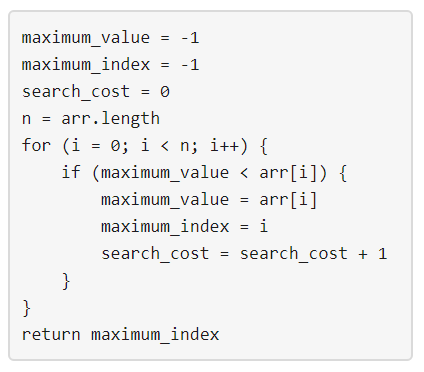Given three integers n, m and k. Consider the following algorithm to find the maximum element of an array of positive integers:

You should build the array arr which has the following properties:
arrhas exactlynintegers.1 <= arr[i] <= mwhere(0 <= i < n).- After applying the mentioned algorithm to
arr, the valuesearch_costis equal tok.
Return the number of ways to build the array arr under the mentioned conditions. As the answer may grow large, the answer must be computed modulo 10^9 + 7.
Example 1:
Input: n = 2, m = 3, k = 1
Output: 6
Explanation: The possible arrays are [1, 1], [2, 1], [2, 2], [3, 1], [3, 2] [3, 3]
Example 2:
Input: n = 5, m = 2, k = 3
Output: 0
Explanation: There are no possible arrays that satisify the mentioned conditions.
Example 3:
Input: n = 9, m = 1, k = 1
Output: 1
Explanation: The only possible array is [1, 1, 1, 1, 1, 1, 1, 1, 1]
Example 4:
Input: n = 50, m = 100, k = 25
Output: 34549172
Explanation: Don't forget to compute the answer modulo 1000000007
Example 5:
Input: n = 37, m = 17, k = 7
Output: 418930126
Constraints:
1 <= n <= 501 <= m <= 1000 <= k <= n
O(N * K * M^2) dynamic programming
State:
dp[i][j][maxV]: the number of ways to build an array of arr[0, i] (length i + 1), with j search costs and max number of maxV.
Transition:
1. if the current value V is not a new max number, then V must be in range [1, maxV], otherwise V will be a new max number. So the current number has maxV different choices, each choice corresponds to the number of ways of shorter length by 1, same search cost and max number, dp[i - 1][j][maxV]. So dp[i][j][maxV] += dp[i - 1][j][maxV] * maxV;
2. if the current value V is a new max number, then V only has one option, maxV. We can append maxV to all arrays of shorter length by 1, smaller search cost by 1 and max value smaller than maxV to get array of longer length by 1, bigger search cost by 1 and max number maxV. So dp[i][j][maxV] = Sum of (dp[i - 1][j - 1][smallerV]), smallerV in [1, maxV - 1].
Init:
For array of 1 element, there is 1 way for each different number choice with a search cost of 1. This is true because maximum value is initially set to < 0, so any number choice will incur an update. dp[0][1][maxV] = 1, maxV in [1, m].
Answer: Sum of dp[n - 1][k][maxV], maxV in [1, m]. For each valid array, its max value must be in [1, m], so the final answer is the sum over all max value possibilities for length n and search cost k.
class Solution { public int numOfArrays(int n, int m, int k) { int mod = (int)1e9 + 7; long[][][] dp = new long[n][k + 1][m + 1]; for(int maxV = 1; maxV <= m; maxV++) { dp[0][1][maxV] = 1; } for(int i = 1; i < n; i++) { for(int j = 1; j <= k; j++) { for(int maxV = 1; maxV <= m; maxV++) { //newly added number is not a new max value dp[i][j][maxV] = (dp[i][j][maxV] + dp[i - 1][j][maxV] * maxV) % mod; //newly added number is a new max value for(int smallerV = 1; smallerV < maxV; smallerV++) { dp[i][j][maxV] = (dp[i][j][maxV] + dp[i - 1][j - 1][smallerV]) % mod; } } } } long ans = 0; for(int v = 1; v <= m; v++) { ans = (ans + dp[n - 1][k][v]) % mod; } return (int)ans; } }
The for loop to for case: newly added number is a new max value does redundant work as it sums up the same prefixes dp[i - 1][j - 1][smallerV] repeatly. To optimize this, we can create a prefix sum array to save the previous summation results. This reduces the runtime of computing newly added number is a new max value case from O(M) to O(1).
class Solution { public int numOfArrays(int n, int m, int k) { int mod = (int)1e9 + 7; long[][][] dp = new long[n][k + 1][m + 1]; long[][][] ps = new long[n][k + 1][m + 1]; for(int maxV = 1; maxV <= m; maxV++) { dp[0][1][maxV] = 1; ps[0][1][maxV] = ps[0][1][maxV - 1] + 1; } for(int i = 1; i < n; i++) { for(int j = 1; j <= k; j++) { for(int maxV = 1; maxV <= m; maxV++) { //newly added number is not a new max value dp[i][j][maxV] = (dp[i][j][maxV] + dp[i - 1][j][maxV] * maxV) % mod; //newly added number is a new max value dp[i][j][maxV] = (dp[i][j][maxV] + ps[i - 1][j - 1][maxV - 1]) % mod; ps[i][j][maxV] = (ps[i][j][maxV - 1] + dp[i][j][maxV]) % mod; } } } long ans = 0; for(int v = 1; v <= m; v++) { ans = (ans + dp[n - 1][k][v]) % mod; } return (int)ans; } }